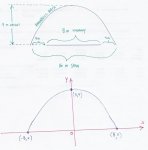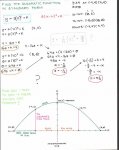We have just started this chapter, and I was grouped with 2 others that didn't want to work 'together', so the questions were divided up ... this is mine ... I have attempted it, and done the initial graph - but don't know what formula to start with, and don't know what they are asking when they say "y-axis bisects the highway and the parabolic arch and the x-axis is placed at the base of the parabola".
Any help or pointers would be muchly appreciated!
A wildlife corridor must be designed to arch over a major highway. The arch over the highway is to be constructed in the shape of a parabola. The highway is 8m wide and will be centered under the parabolic arch. the arch must span a total width of 16m at it's base. the arch must provide a minimum clearance of 4m over the highway.
a) Sketch the parabolic arch and highway, labeling all relevant dimentions
b) Place a coordinate system on your sketch above so that the y-axis bisects the highway and the parabolic arch and the x-axis is placed at the base of the parabola. Find the quadratic function in standard form that describes the height of the arch, y, as a function of the horizontal distance from the center, x. Show all your steps.
c) State the maximum height of the arch over the highway (approximate to the nearest tenth of a meter)[/b]
Any help or pointers would be muchly appreciated!
A wildlife corridor must be designed to arch over a major highway. The arch over the highway is to be constructed in the shape of a parabola. The highway is 8m wide and will be centered under the parabolic arch. the arch must span a total width of 16m at it's base. the arch must provide a minimum clearance of 4m over the highway.
a) Sketch the parabolic arch and highway, labeling all relevant dimentions
b) Place a coordinate system on your sketch above so that the y-axis bisects the highway and the parabolic arch and the x-axis is placed at the base of the parabola. Find the quadratic function in standard form that describes the height of the arch, y, as a function of the horizontal distance from the center, x. Show all your steps.
c) State the maximum height of the arch over the highway (approximate to the nearest tenth of a meter)[/b]



